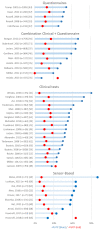Predictability of Fall Risk Assessments in Community-Dwelling Older Adults: A Scoping Review
- PMID: 37765742
- PMCID: PMC10536675
- DOI: 10.3390/s23187686
Predictability of Fall Risk Assessments in Community-Dwelling Older Adults: A Scoping Review
Abstract
Fall risk increases with age, and one-third of adults over 65 years old experience a fall annually. Due to the aging population, the number of falls and related medical costs will progressively increase. Correct prediction of who will fall in the future is necessary to timely intervene in order to prevent falls. Therefore, the aim of this scoping review is to determine the predictive value of fall risk assessments in community-dwelling older adults using prospective studies. A total of 37 studies were included that evaluated clinical assessments (questionnaires, physical assessments, or a combination), sensor-based clinical assessments, or sensor- based daily life assessments using prospective study designs. The posttest probability of falling or not falling was calculated. In general, fallers were better classified than non-fallers. Questionnaires had a lower predictive capability compared to the other assessment types. Contrary to conclusions drawn in reviews that include retrospective studies, the predictive value of physical tests evaluated in prospective studies varies largely, with only smaller-sampled studies showing good predictive capabilities. Sensor-based fall risk assessments are promising and improve with task complexity, although they have only been evaluated in relatively small samples. In conclusion, fall risk prediction using sensor data seems to outperform conventional tests, but the method's validity needs to be confirmed by large prospective studies.
Keywords: aging population; community dwelling older adults; fall risk assessment; sensor.
Conflict of interest statement
The authors declare no conflict of interest.
Figures
Similar articles
-
Prevention of falls and fall-related injuries in community-dwelling seniors: an evidence-based analysis.Ont Health Technol Assess Ser. 2008;8(2):1-78. Epub 2008 Oct 1. Ont Health Technol Assess Ser. 2008. PMID: 23074507 Free PMC article.
-
Sensor-derived physical activity parameters can predict future falls in people with dementia.Gerontology. 2014;60(6):483-92. doi: 10.1159/000363136. Epub 2014 Aug 28. Gerontology. 2014. PMID: 25171300 Free PMC article.
-
A modified fall risk assessment tool that is specific to physical function predicts falls in community-dwelling elderly people.J Geriatr Phys Ther. 2014 Oct-Dec;37(4):159-65. doi: 10.1519/JPT.0b013e3182abe7cb. J Geriatr Phys Ther. 2014. PMID: 24577358
-
New methods for fall risk prediction.Curr Opin Clin Nutr Metab Care. 2014 Sep;17(5):407-11. doi: 10.1097/MCO.0000000000000081. Curr Opin Clin Nutr Metab Care. 2014. PMID: 24992225 Review.
-
Exercise for preventing falls in older people living in the community.Cochrane Database Syst Rev. 2019 Jan 31;1(1):CD012424. doi: 10.1002/14651858.CD012424.pub2. Cochrane Database Syst Rev. 2019. PMID: 30703272 Free PMC article.
Cited by
-
Effect of resistance training on body composition and physical function in older females with sarcopenic obesity-a systematic review and meta-analysis of randomized controlled trials.Front Aging Neurosci. 2025 Apr 30;17:1495218. doi: 10.3389/fnagi.2025.1495218. eCollection 2025. Front Aging Neurosci. 2025. PMID: 40370749 Free PMC article.
-
Factors Associated with Falls in Community-Dwelling Older Adults: A Subgroup Analysis from a Telemergency Service.Geriatrics (Basel). 2024 May 29;9(3):69. doi: 10.3390/geriatrics9030069. Geriatrics (Basel). 2024. PMID: 38920425 Free PMC article.
-
Ability of Heart Rate Recovery and Gait Kinetics in a Single Wearable to Predict Frailty: Quasiexperimental Pilot Study.JMIR Form Res. 2024 Oct 3;8:e58110. doi: 10.2196/58110. JMIR Form Res. 2024. PMID: 39361400 Free PMC article.
-
Validity of the German version of the Stay Independent Questionnaire applied by telephone interview: A diagnostic accuracy study.PLoS One. 2025 Sep 3;20(9):e0319726. doi: 10.1371/journal.pone.0319726. eCollection 2025. PLoS One. 2025. PMID: 40901809 Free PMC article.
References
-
- World Health Organization Falls. April 2021. [(accessed on 13 June 2023)]; Available online: https://www.who.int/news-room/fact-sheets/detail/falls.
-
- VeiligheidNL Feiten Cijfers—Valpreventie—VeiligheidNL. September 2020. [(accessed on 13 June 2023)]. Available online: https://www.veiligheid.nl/valpreventie/feiten-cijfers.
-
- Stam C., Blatter B. Letsels 2020: Kerncijfers LIS. Tech. Rep. 2021;2:11.
Publication types
LinkOut - more resources
Full Text Sources



